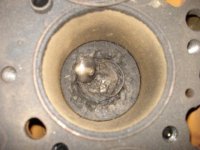There are a couple of things here I want to mention. Firstly, the use of titanium retainers for daily driven engines is a death warrant for durability. There really is no way around it. The material is just not best for long term in this application. It will fail with prolonged use.
On to springs: Our Pro/Sport springs are 90-94 pounds on the seat ( depending on your final installed height ) and with most cams around 225 lbs on the nose. Which is getting close to all you want and certainly all you would ever need. This compares to under 80 and 175 for the stock spring. Keeping in mind that the stock springs are fine for the mildly modified engines that run the stock RPM ranges and back pressures. The Pros are designed with enough pressure for control but not so much that the bad side effects of a heavier spring are harmful. Push tube deflection/bending, retainer failure, lock failure and accelerated cross head wear are all within a safe limit. Heavier springs, we found, increase wear and the chances of failures. Also, the camshaft in the Cummins is the single highest wearing piece. Nothing else is even close. This is why Cummins during oil testing for new formulations always go to the cam wear testing and data first. They know if the oil will pass the 350 hour test for the 5.9 and 6.7 it will be fine for other hard parts. Finally, cam and block journal interfaces on the furthest rear journal is of particular concern and the first thing to begin a downward spiral. This journal always fails first. It may be in part because the Cummins block uses only one bearing insert ( the number 1) where the thrust loads are highest from the cam gear. Also the rear journals distance from the thrust loads applied on the nose coupled with the leverage of the long (31”) camshaft itself pushing on the rear journal.
Sure you can change the push tube material to something more robust to run a high pressure spring, but you still do not address the retainers, locks, high cross head wear, very fast cam lobe wear rates, and the HP loss associated with compressing the heavier springs.
Unfortunately, I have seen the damage caused by too much spring used it the Cummins. It is expensive when things go wrong. Recalling that we could have used any pressure we wanted as the final design, but we had enough data to support NOT going any higher. The benefits are: never a retainer or lock failure by any customer, the lowest possible cam wear rates, enough pressure to control the valves, and less frictional horsepower drag/loss.
As the first company to bring a drop in spring to the market for the 5.9 Cummins - years ahead of the rest - we have an exhaustive data set and customer base to use in evaluation for future improvements. Some of which have been implemented already.
SN~

